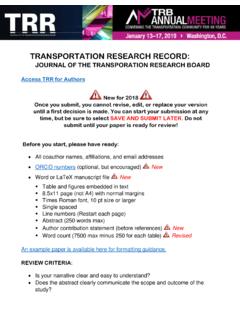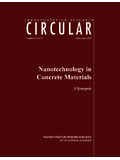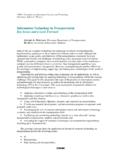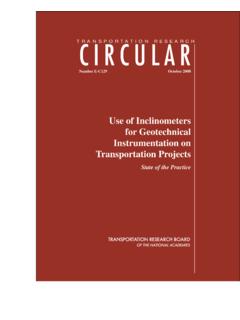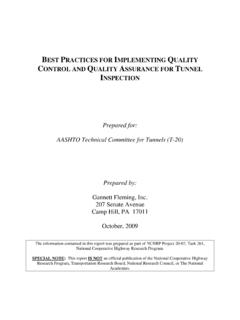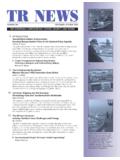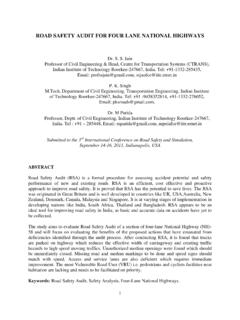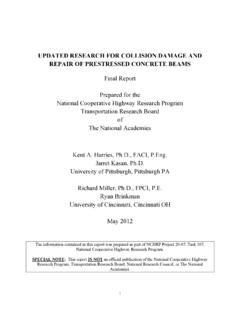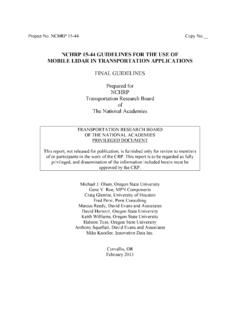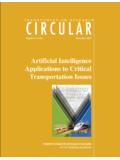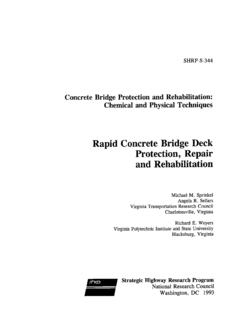Transcription of CHEMICAL PROPERTIES OF ASPHALTS AND THEIR …
1 SHRP-A/UWP-91-510. CHEMICAL PROPERTIES of ASPHALTS and THEIR relationship to Pavement Performance Raymond E. Robertson Western Research Institute Laramie, WY. Strategic Highway Research Program National Research Council Washington, 1991. SHRP-A/UWP-91-510. Contract A-002A. Product Code 1001, 1007. Program Manager: Edward T. Harrigan Project Manager: Jack S. Youtcheff Program Area Secretary: Juliet Narsiah March 1991. Reprinted November 1993. key words: adhesion aging asphalt CHEMICAL mode failure models fatigue cracking imermolecular metals moisture damage oxidation pavement performance permanent deformation polarity rutting thermal cracking virgin asphalt Strategic Highway Research Program National Research Council 2101 Constitution Avenue Washington, DC 20418. (202) 334-3774. This manual represents the views of the author only, and is not necessarily reflective of the views of the National Research Council, the views of SHRP, or SHRP's sponsor.
2 The results reported here are not necessarily in agreement with the results of other SHRP research activities. They are reported to stimulate review and discussion within the research community. 50/NAP/1193. Acknowledgments The research described herein was supported by the Strategic Highway Research Program (SHRP). SHRP is a unit of the National Research Council that was authorized by section 128 of the Surface Transportation and Uniform Relocation Assistance Act of 1987. This project was conducted by the Western Research Institute in cooperation with the Pennsylvania Transportation Institute, the Texas Transportation Institute, and SRI. International. Raymond E. Robertson was the principal investigator. The support and encouragement of Dr. Edward T. Harrigan, SHRP asphalt Program Manager, and Dr. Jack Youtcheff, SHRP Technical Contract Manager, are gratefully acknowledged. The experimental work cited herein was conducted by Dr.
3 J. F. Branthaver, Dr. K. Ensley, Dr. J. Duvall, H. Plancher, P. M. Harnsberger, S. C. Preece, F. A. Reid, J. Tauer, M. Aldrich, A. Gwin, M. Catalfomo, G. Miyake, and J. Wolf. THEIR support in the preparation of this report is gratefully acknowledged. The review of this manuscript by Dr. J. Claine Petersen, former principal investigator for A-002A; Dr. Jan F. Branthaver at WRI; and Dr. David Anderson at PTI, co-principal investigator for A-002A; and Dr. Edward T. Harrigan and Dr. Jack Youtcheff of SHRP is hereby acknowledged.. nl Contents Introduction .. 1. Objectives of the SHRP asphalt Program .. 1. Purpose of Report .. 2. Chemistry .. 3. Molecular Level .. 3. Typical Species in Virgin asphalt .. 3. Oxidation to Form New Molecules .. 5. Metals .. 9. Polarity .. 9. Intermolecular Level .. 10. CHEMICAL Mode of asphalt .. 17. Speculation on relationship of Chemistry to Pavement Performance .. 20. General Comments .. 20. Aging.
4 21. Speculation on the relationship of Composition to Various Failure Models .. 23. Rutting and Permanent Deformation .. 24. Thermal and Fatigue Cracking .. 25. Adhesion and Moisture Damage .. 26. Summary .. 29. V. List of Structures 1 Molecular Fragment of an Aliphatic Hydrocarbon .. 4. 2 Molecular Fragment of an Aromatic Hydrocarbon .. 4. 3 Molecular Fragmem of an Aromatic Hydrocarbon .. 4. 4 Molecular Fragment of an Aliphatic and Aromatic Hydrocarbon .. 4. 5 Molecular Fragmem of a Pyridine .. 5. 6 Molecular Fragmem of a Thiophene .. 5. 7 Molecular Fragmem Showing Benzyl Carbon .. 6. 8 Molecular Fragmem of a Ketone .. 6. 9 Molecular Fragmem of a Carboxylic Acid .. 6. 10 Molecular Fragmem of a Sodium Carboxylate .. 7. 11 Molecular Fragment of a Calcium Carboxylate .. 7. 12 Molecular Fragment of a Carboxylic Anhydride .. 7. 13 Molecular Fragment of a Phenol .. 7. 14 Molecular Fragment of a Homolog .. 8. 15 Molecular Fragment of a Homolog.
5 8. vii 16 Molecular Fragment of a Homolog .. 8. 17 Molecular Fragment of a Quinolone .. 8. 18 Molecular Fragment of a Sulfoxide .. 9. 19 Metalloporphyrin .. 9. Vll"1"". List of Figures 1A Randomized Molecules .. " " " * " " .. 10. 1B Organized Molecules . o o 10. 2 Three Dimensional Molecular Matrix .. 11. 3 Chromatograms .. 14. 4 Effects of Temperature on Aging Kinetics of an asphalt Sensitive to Molecular Structuring .. 17. 5 Performance .. 21. ix F,_C_ZVE S_Y. The chemistry of petroleum asphalt at the molecular and intermolecular levels is discussed herein and a combination of interpretation and speculation placed on how CHEMICAL data may explain performance characteristics in roadways. At the molecular level historical studies have shown that there are at least hundreds of thousands of unique molecular species that exist within any particular asphalt . ASPHALTS are known to be comprised of molecular species that vary widely in polarity and molecular weight.
6 The major objective of this portion of the work is to explain behavioral characteristics of ASPHALTS in terms of chemistry. Polarity is a very major contributor to the performance characteristics. Polar materials tend to associate strongly into a matrix which is dispersed in less polar and non-polar materials. In general, the mechanical or structural PROPERTIES of asphalt are related to the intermolecular structuring among polar components. These polar interactions may arise by involvement of any of numerous different CHEMICAL species. The exact nature of the CHEMICAL specie is less important than the overall assemblage of a set of polar materials to form a matrix within the non-polar continuous medium. The matrix gives elastic character to the asphalt while the continuous non- polar phase gives a viscous component to asphalt . It is speculated that excessive structuring leads to brittle cements which tends to crack while too little structuring leads to materials which deform under stress.
7 Oxidation adds to the age hardening and brittleness of asphalt cement by contributing additional polar materials to the structured zones within the binder. At very low temperature it appears that the xi non-polar materials also tend to organize into a very rigid material, and that this rigid material shrinks at low temperature. It is speculated that this type of shrinkage is largely responsible for low temperature cracking. A second major objective is to translate research methods into test methods. Numerous types of research methods have been employed to differentiate among ASPHALTS with an emphasis on identifying methods which distinguish among ASPHALTS in the same fashion that they are distinguished by THEIR performance characteristics. The expected advantages of this work, both technical and economic, are to develop methods for selection of ASPHALTS that will perform in a predictable fashion thereby alleviating the current conunon problem of premature road failure.
8 Throughout the program, both users and producers of petroleum asphalt have worked closely with SHRP contractor personnel both to give advice on program direction and to maintain a sense of what is practically implementable in each sector. As with any new development questions arise as to how much specialization will be required for implementation of new test methods. Certainly new test methods could become extraordinarily complex, but it is still another objective to assure that there is no more complexity than is absolutely necessary. Problems of implementation, therefore, should be minimized and espec'ially so when one considers that each new test method will enter a round robin test program in both state highway and user laboratories. The round robin effort, in fact, has already xii begun. Finally, this work is supported by public funding and the results that are implemented into new test methodology will be public domain.
9 Xiii INTRODUCTION. Objectives of the SHRP asphalt Program The SHRP asphalt research area is a highly focused endeavor which ultimately must develop specifications for binders and asphalt -aggregate mixtures that relate to the performance of both binders and mixtures in pavements. To accomplish this the fundamental material PROPERTIES must be known first. Then fundamental PROPERTIES are to be used to develop meaningful specifications. The current specifications for petroleum asphalt are little more than a quality control exercise for the refiner's vacuum crude tower operations, hence there is little or no distinction among ASPHALTS other than a set of viscosities at two elevated temperatures and a mix plant oxidation susceptibility. That is, all of many ASPHALTS may be classified as, for example, AC-20, and all will be applied as if they are a single material. Yet, THEIR performance characteristics in pavements often vary quite significantly.
10 The results of using poorly classified ASPHALTS have been rude and costly surprises in the form of various types of early failures with increasing frequency. It behooves the user, therefore, to determine what PROPERTIES of asphalt binders are reflected in pavement performance and then select binders which have desirable performance PROPERTIES . From a practical viewpoint, no doubt many petroleum residua will require modification to prepare ASPHALTS that have desirable performance characteristics. Purpose of Report The purpose of this report is to describe the current status of the SHRP CHEMICAL studies of petroleum asphalt . It is intended to be instructive to the non-chemist and further is a speculative effort to correlate some of the known CHEMICAL PROPERTIES of ASPHALTS with pavement performance characteristics. It is generally believed that performance- based specifications for binders will be mainly physical property tests.
